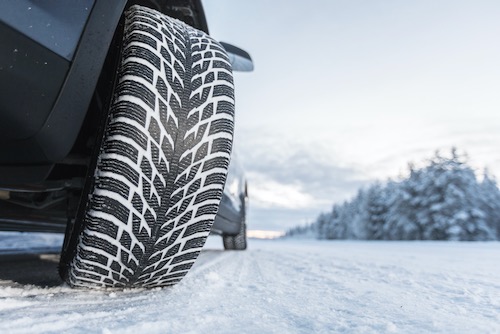Winter tires are tires that are specially made to handle conditions that are present during the winter season. These include cold temperatures, i.e. below 45 degrees Fahrenheit, snow, ice and also slush. To be able to withstand the low temperatures, the rubber compound uses additives that will ensure a soft and agile tire even at very low temperatures. The absent of this additive in all-season tires is what makes them turn hard at low temperatures and why it is recommended to use winter tires instead of all-season tires at temperatures below 45 degrees Fahrenheit.
It is of course not only the additives that make the winter tires to remain soft at low temperatures that differentiate the winter tires from all-season tires. You also have also a tread pattern and design that will ensure that you have grip on the challenging surfaces such as snow, ice and slush. Some tires have studs to improve the grip on ice, these are the so called studded tires. They are not allowed to be used in all states and provinces in North America, so you have to check what tire options are available. You also have the non-studded tires that will have to rely on other additives to the tread and design elements to improve the grip.
Not all winter tires are the same, high quality premium tires will have better ability to perform during the winter due to its superior tire technology, that can create grip through innovations in the tread and by using carefully designed sipes. All this will contribute to better performance when driving on snow and ice. You also have to ensure that the tires can handle slush. Slush is the wet slur or water and snow, that is very slippery and can cause slushplaning where the slush gets in between the tires and the road surface, so the tires start to glide on top of the slush. This will cause you to lose all control over the vehicle. To avoid this from happening, the tread has to be able to channel away the slush to the sides of the tires. The better ability they have the better it is. This can be done though different techniques that don’t differ too much than from the aquaplaning prevention innovations.
For snow, the studs are not what will create the majority of the grip, this is why the non-studded and the studded perform equally good on snow. Here it comes down to the tread and how well the tread can handle the snow and create enough traction and grip to ensure that you can both brake quickly to a full stop and accelerate when you start. This is why you need the full combination of rubber compound, with the proper tread and the design of the tread, the additions of additives and possibly studs or gripping particles and then sipes in the tread to enhance the grip.
For more information regarding tires that excel on winter conditions, visit: www.nokiantires.com
